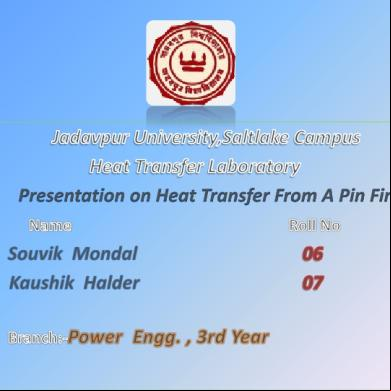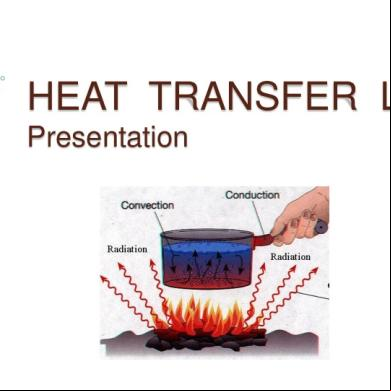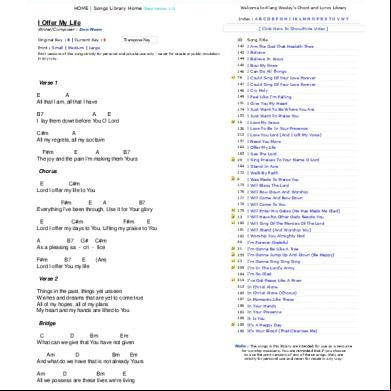Pin Fin 4w1e15
This document was ed by and they confirmed that they have the permission to share it. If you are author or own the copyright of this book, please report to us by using this report form. Report 3i3n4
Overview 26281t
& View Pin Fin as PDF for free.
More details 6y5l6z
- Words: 865
- Pages: 20
TITLE :- Heat Transfer From A Pin Fin
OBJECT:- (1) To study the temperature distribution along the length of a pin fin under forced convection with tip insulated. (2) To find out the heat transfer coefficient of the pin fin & pin fin effectiveness.
What is heat transfer ? Heat Transfer is the exchange of thermal energy due to temp diff.This is of mainly 3 types-> Conduction is a mode of transfer of energy within and between bodies of matter, due to a temperature gradient. Conduction means collisional and diffusive transfer of kinetic energy of particles of matter. Conduction takes place in all forms of matter, i.e. solids, liquids, gases. Heat tends to flow from a higher temperature body to a lower temperature body. Convection is the movement of molecules within fluids i.e. liquids, gases.It cannot take place in solids, as neither bulk current flows nor significant diffusion can take place in solids.Convection is one of the major modes of heat transfer and mass transfer. In the context of heat and mass transfer,Convection is used to refer to the sum of Advective and Diffusive transfer. Radiation is energy emitted by matter as Electromagnetic waves due to the storage of thermal energy that all matter possesses that has a temperature above absolute zero. Thermal radiation propagates through the vacuum of space.
Convection is of two types – (i) Natural Convection
& (ii) Forced Convection Natural convection is a type of heat transfer, in which the fluid motion is not generated by any external source (i.e. a pump, fan, blower etc.) but only by density differences in the fluid occurring due to temperature gradients. Forced Convection is a type of heat transfer,in which the fluid movement results from external surface forces such as a fan or pump or blower. Forced convection is typically used to increase the rate of heat exchange. Many types of mixing also utilize forced convection to distribute one substance within another.
Application of extended surfaces in Convection:For both modes of convection heat transfer i.e. Natural &Forced Convection,extended surface known as Fin, is used to increase the rate of heat transfer from a surface to a fluid where heat transfer coefficient of the surface and temp. diff. between them is not possible to increase. How Fin increases the heat transfer rate? Fin increases the surface area available for heat transfer.
Wide application of fins:Fins are vastly used on the radiator surface,on the boiler water tubes,heat exchanger tubes & sometimes on Electronic equipments.
APPLICATION OF PIN FIN IN PRACTICAL LIFE
pin fin heat sink is used to cool the processer .
Temperature Readings
Delivery Pipe
Voltmeter Readings
Heater
Ammeter Readings
Manometer Rectangular Duct With Pin Fin inside it Pump
The Front view of the experimental setup where Heat Transfer From Pin Fin experiment was done.
Pin Fin
Temperature Point
Open Rectangular Channel of the device from where the air is sucked
150 mm
15mm
30mm
30mm
30mm
30mm
15mm
100 mm 12 mm
One Side Opened Rectangular Duct With A Circular Pin Fin At The Center
Hot Air Air is sucked inside
Pin fin
Air Flow Direction is shown here Through the Rectangular Duct
Assumptions:(i) Steady state Heat Conduction. (ii) Pin Fin Tip insulated i.e. no heat convection from the pin fin tip.
No Heat Convection
(iii) The shape of pinfin is cylindrical so that perfect fluid and thermal boundary layer can construct.
Boundary layer over cylinder
Mathematical Formulae we used for calculation:T-Tf = Cosh m(L-x) Cosh mL Ts-Tf Where,
m= hP kA .
qfin= q q
ideal
Where, .
q=(Ts-Tf)(hPAk) tanh mL & qideal=hPL(Ts-Tf)
Observation Table:-
Sl No 1. 2. 3.
Heater Voltage (V)
Heater Current (Amp)
Manom eter reading Cm of H2O
40 60 70
0.17 0.26 0.30
1.6 1.6 1.6
Steady T1 . ( c)
74 96 I 102
State T2 . ( c)
64 82 86
Pin T3 . ( c)
56 69 72
Fin T4 . ( c)
51 61 64
Temp Fluid . Ambient T5 Temp. . ( c) T6 . ( c)
48 56 58
33 34 34
Specifications:(i)Width=150 mm, Breadth=100 mm (ii) Diameter of the Fin=12 mm (iii) Diameter of the Orifice=20 mm (iv) Diameter of the Delivery Pipe=40 mm (v) Length of Fin=150 mm (vi) Co-efficient of Discharge=0.61
Sample Calculation:-
Volume Flow Rate of Air,Q=Cd A1A2 2g[ / -1] w a 2 2 A1 -A2 or,Q=3.199*10-3 m3/sec • Velocity of Flowing Air,V=Q/a=0.242 m/sec •
• Reynolds number,Re=VD/=176.322 • Value of Nusselt number using Correlation,Nu=0.683Re0.466Pr1/3 =6.76 now, T-Tf = Cosh m(L-x) Ts-Tf Cosh mL
let,
Ts=T1, T=T2 & Tf=T6 we get the value of m through iteration technique,m=10.85
• Theoritical Temperatures are, T2-33= Cosh 10.85(0.135-0.03) 74-33 Cosh (10.85*0.135) Or,T2= 63.98 .c
Thus the Other Temperatures are, T3= 57.285 .c T4= 53.179 .c T5= 51.23 .c • Fin Effectiveness, qeff=
q
fin
qwithout fin
(T -T )(hPAk) tanh mL = s f hA(Ts-Tf)
= 27.61
80 70
Temperatures(.c)
60 50
40
Experimental Temperatures
30
Theoritical Temperatures
20 10 0 0
50
100
Length of Fin(mm)
150
Acknowledgement:We are sincerely thankful to our teachers->
(i) Prof. Apurba K. Santra (ii) Prof. Amitava Dutta
(iii) Sri Atish Nandi (iv) Sri Biraswar paul
(v) Sri Prakas Ghosh.
OBJECT:- (1) To study the temperature distribution along the length of a pin fin under forced convection with tip insulated. (2) To find out the heat transfer coefficient of the pin fin & pin fin effectiveness.
What is heat transfer ? Heat Transfer is the exchange of thermal energy due to temp diff.This is of mainly 3 types-> Conduction is a mode of transfer of energy within and between bodies of matter, due to a temperature gradient. Conduction means collisional and diffusive transfer of kinetic energy of particles of matter. Conduction takes place in all forms of matter, i.e. solids, liquids, gases. Heat tends to flow from a higher temperature body to a lower temperature body. Convection is the movement of molecules within fluids i.e. liquids, gases.It cannot take place in solids, as neither bulk current flows nor significant diffusion can take place in solids.Convection is one of the major modes of heat transfer and mass transfer. In the context of heat and mass transfer,Convection is used to refer to the sum of Advective and Diffusive transfer. Radiation is energy emitted by matter as Electromagnetic waves due to the storage of thermal energy that all matter possesses that has a temperature above absolute zero. Thermal radiation propagates through the vacuum of space.
Convection is of two types – (i) Natural Convection
& (ii) Forced Convection Natural convection is a type of heat transfer, in which the fluid motion is not generated by any external source (i.e. a pump, fan, blower etc.) but only by density differences in the fluid occurring due to temperature gradients. Forced Convection is a type of heat transfer,in which the fluid movement results from external surface forces such as a fan or pump or blower. Forced convection is typically used to increase the rate of heat exchange. Many types of mixing also utilize forced convection to distribute one substance within another.
Application of extended surfaces in Convection:For both modes of convection heat transfer i.e. Natural &Forced Convection,extended surface known as Fin, is used to increase the rate of heat transfer from a surface to a fluid where heat transfer coefficient of the surface and temp. diff. between them is not possible to increase. How Fin increases the heat transfer rate? Fin increases the surface area available for heat transfer.
Wide application of fins:Fins are vastly used on the radiator surface,on the boiler water tubes,heat exchanger tubes & sometimes on Electronic equipments.
APPLICATION OF PIN FIN IN PRACTICAL LIFE
pin fin heat sink is used to cool the processer .
Temperature Readings
Delivery Pipe
Voltmeter Readings
Heater
Ammeter Readings
Manometer Rectangular Duct With Pin Fin inside it Pump
The Front view of the experimental setup where Heat Transfer From Pin Fin experiment was done.
Pin Fin
Temperature Point
Open Rectangular Channel of the device from where the air is sucked
150 mm
15mm
30mm
30mm
30mm
30mm
15mm
100 mm 12 mm
One Side Opened Rectangular Duct With A Circular Pin Fin At The Center
Hot Air Air is sucked inside
Pin fin
Air Flow Direction is shown here Through the Rectangular Duct
Assumptions:(i) Steady state Heat Conduction. (ii) Pin Fin Tip insulated i.e. no heat convection from the pin fin tip.
No Heat Convection
(iii) The shape of pinfin is cylindrical so that perfect fluid and thermal boundary layer can construct.
Boundary layer over cylinder
Mathematical Formulae we used for calculation:T-Tf = Cosh m(L-x) Cosh mL Ts-Tf Where,
m= hP kA .
qfin= q q
ideal
Where, .
q=(Ts-Tf)(hPAk) tanh mL & qideal=hPL(Ts-Tf)
Observation Table:-
Sl No 1. 2. 3.
Heater Voltage (V)
Heater Current (Amp)
Manom eter reading Cm of H2O
40 60 70
0.17 0.26 0.30
1.6 1.6 1.6
Steady T1 . ( c)
74 96 I 102
State T2 . ( c)
64 82 86
Pin T3 . ( c)
56 69 72
Fin T4 . ( c)
51 61 64
Temp Fluid . Ambient T5 Temp. . ( c) T6 . ( c)
48 56 58
33 34 34
Specifications:(i)Width=150 mm, Breadth=100 mm (ii) Diameter of the Fin=12 mm (iii) Diameter of the Orifice=20 mm (iv) Diameter of the Delivery Pipe=40 mm (v) Length of Fin=150 mm (vi) Co-efficient of Discharge=0.61
Sample Calculation:-
Volume Flow Rate of Air,Q=Cd A1A2 2g[ / -1] w a 2 2 A1 -A2 or,Q=3.199*10-3 m3/sec • Velocity of Flowing Air,V=Q/a=0.242 m/sec •
• Reynolds number,Re=VD/=176.322 • Value of Nusselt number using Correlation,Nu=0.683Re0.466Pr1/3 =6.76 now, T-Tf = Cosh m(L-x) Ts-Tf Cosh mL
let,
Ts=T1, T=T2 & Tf=T6 we get the value of m through iteration technique,m=10.85
• Theoritical Temperatures are, T2-33= Cosh 10.85(0.135-0.03) 74-33 Cosh (10.85*0.135) Or,T2= 63.98 .c
Thus the Other Temperatures are, T3= 57.285 .c T4= 53.179 .c T5= 51.23 .c • Fin Effectiveness, qeff=
q
fin
qwithout fin
(T -T )(hPAk) tanh mL = s f hA(Ts-Tf)
= 27.61
80 70
Temperatures(.c)
60 50
40
Experimental Temperatures
30
Theoritical Temperatures
20 10 0 0
50
100
Length of Fin(mm)
150
Acknowledgement:We are sincerely thankful to our teachers->
(i) Prof. Apurba K. Santra (ii) Prof. Amitava Dutta
(iii) Sri Atish Nandi (iv) Sri Biraswar paul
(v) Sri Prakas Ghosh.










